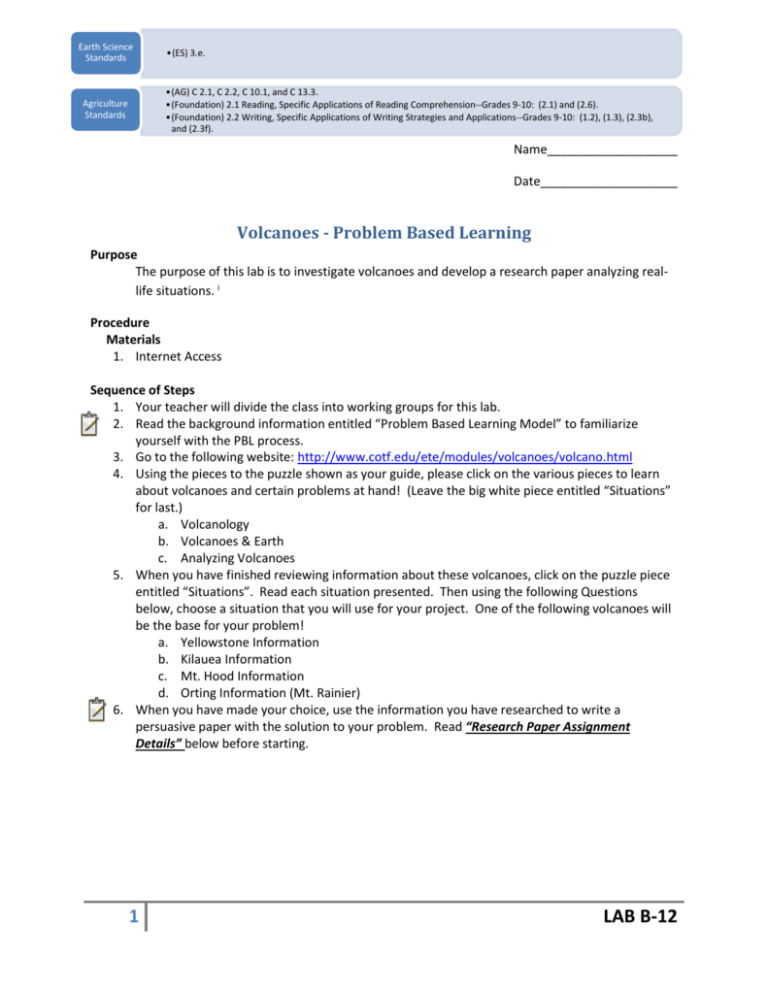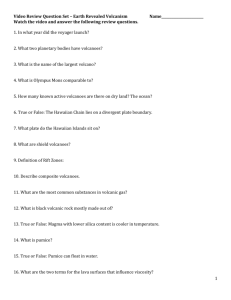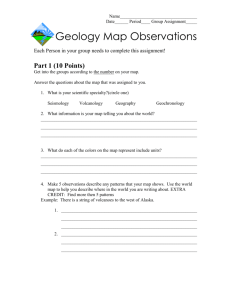B-12 Volcanoes Problem Based Learning
advertisement

Earth Science Standards •(ES) 3.e. •(AG) C 2.1, C 2.2, C 10.1, and C 13.3. •(Foundation) 2.1 Reading, Specific Applications of Reading Comprehension--Grades 9-10: (2.1) and (2.6). •(Foundation) 2.2 Writing, Specific Applications of Writing Strategies and Applications--Grades 9-10: (1.2), (1.3), (2.3b), and (2.3f). Agriculture Standards Name___________________ Date____________________ Volcanoes - Problem Based Learning Purpose The purpose of this lab is to investigate volcanoes and develop a research paper analyzing reallife situations. i Procedure Materials 1. Internet Access Sequence of Steps 1. Your teacher will divide the class into working groups for this lab. 2. Read the background information entitled “Problem Based Learning Model” to familiarize yourself with the PBL process. 3. Go to the following website: http://www.cotf.edu/ete/modules/volcanoes/volcano.html 4. Using the pieces to the puzzle shown as your guide, please click on the various pieces to learn about volcanoes and certain problems at hand! (Leave the big white piece entitled “Situations” for last.) a. Volcanology b. Volcanoes & Earth c. Analyzing Volcanoes 5. When you have finished reviewing information about these volcanoes, click on the puzzle piece entitled “Situations”. Read each situation presented. Then using the following Questions below, choose a situation that you will use for your project. One of the following volcanoes will be the base for your problem! a. Yellowstone Information b. Kilauea Information c. Mt. Hood Information d. Orting Information (Mt. Rainier) 6. When you have made your choice, use the information you have researched to write a persuasive paper with the solution to your problem. Read “Research Paper Assignment Details” below before starting. 1 LAB B-12 Problem Based Learning Model 1. Read and analyze the problem scenario. Check your understanding of the scenario by discussing it within your group. A group effort will probably be more effective in deciding what the key factors are in this situation. Because this is a real problem solving situation, your group will need to actively search for the information necessary to solve the problem. 2. List what is known. Start a list in which you write down everything you know about this situation. Begin with the information contained in the scenario. Add knowledge that group members bring. (You may want a column of things people think they know, but are not sure!) 3. Develop a problem statement. A problem statement should come from your analysis of what you know. In one or two sentences you should be able to describe what it is that your group is trying to solve, produce, respond to, or find out. The problem statement may have to be revised as new information is discovered and brought to bear on the situation. 4. List what is needed. Prepare a list of questions you think need to be answered to solve the problem. Record them under a second list titled: "What do we need to know?" Several types of questions may be appropriate. Some may address concepts or principles that need to be learned in order to address the situation. Other questions may be in the form of requests for more information. These questions will guide searches that may take place on-line, in the library, or in other out-of-class searches. 5. List possible actions. List recommendations, solutions, or hypotheses under the heading: "What should we do?" List actions to be taken, e.g., question an expert, get on-line data, visit library. 6. Analyze information. Analyze information you have gathered. You may need to revise the problem statement. You may identify more problem statements. At this point, your group will likely formulate and test hypotheses to explain the problem. Some problems may not require hypotheses; instead a recommended solution or opinion (based on your research data) may be appropriate. 7. Present findings. Prepare a report in which you make recommendations, predictions, inferences, or other appropriate resolution of the problem based on your data and background. Be prepared to support your recommendation. Note: The steps in this model may have to be visited several times. Steps two through five may be conducted concurrently as new information becomes available. As more information is gathered, the problem statement may be refined or altered. 2 LAB B-12 Research Paper Assignment Details 1. It should be approximately 2 pages long, double spaced, and must be written in 12 point font (either Arial or Times New Roman only). 2. Please include a title page that has “Volcano Project”, the name of your situation, your name, and the date. You may use any font for your title page and can include a picture if you choose. 3. Your paper needs to include and answer the following situation: a. Decide… Whether to build a new high school in the shadow of Mt. Rainier. What are the prospects for the population near Kilauea? What should be done in the Portland area when Mt. Hood starts acting like Mt. St. Helens? What should be done if we are facing an eruption in Yellowstone as devastating as a nuclear attack? 4. Answer the situation and problem presented above. Make a suggestion that they can follow. (Use the various puzzle pieces for the places.) 5. Assess the type of volcano at hand and the damage that could be caused. (Use the Volcanology puzzle piece.) 6. Determine the risk analysis for the volcano problem in your situation. (Use the Analyzing Volcanoes puzzle piece.) Paper Due Date: ___________________________________ i (2008). Volcanoes PBL. Atwater High School Agriculture Department. 3 LAB B-12






